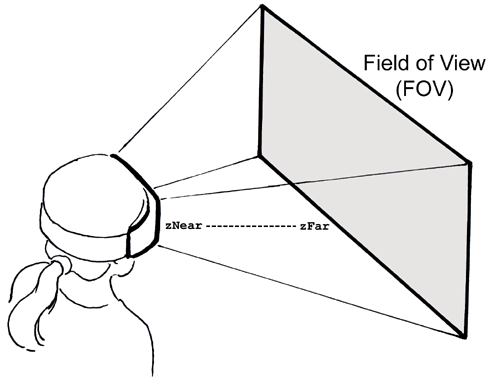This is an experimental technology
Because this technology's specification has not stabilized, check the compatibility table for usage in various browsers. Also note that the syntax and behavior of an experimental technology is subject to change in future versions of browsers as the specification changes.
The VRFieldOfView interface of the WebVR API represents a field of view defined by 4 different degree values describing the view from a center point.

Constructor
VRFieldOfView()- Creates a new
VRFieldOFViewobject.
Properties
This interface doesn't define any of its own properties; however, it does inherit those of its parent interface, VRFieldOfViewReadOnly.
VRFieldOfViewReadOnly.upDegreesRead only- The number of degrees upwards that the field of view extends in.
VRFieldOfViewReadOnly.rightDegreesRead only- The number of degrees to the right that the field of view extends in.
VRFieldOfViewReadOnly.downDegreesRead only- The number of degrees downwards that the field of view extends in.
VRFieldOfViewReadOnly.leftDegreesRead only- The number of degrees to the left that the field of view extends in.
Examples
The following simple example shows a function that can be used to set a custom field of view with four specified degree values for up, right, down and left. The VRFieldOfView() constructor is used to create a VRFieldOfView object from the supplied values, which is then fed into the setFieldOfView() method (the default zNear and zFar values are always used, in this case.)
function setCustomFOV(up,right,down,left) {
var testFOV = new VRFieldOfView(up,right,down,left);
gHMD.setFieldOfView(testFOV,testFOV,0.01,10000.0);
var lEye = gHMD.getEyeParameters('left');
var rEye = gHMD.getEyeParameters('right');
console.log(lEye.currentFieldOfView);
console.log(rEye.currentFieldOfView);
}
Note: When testing, setting a weird/tiny field of view can really mess up your view. IT is a good idea to grab the current field of view first (using VREyeParameters.currentFieldOfView) before making any drastic changes, so you can reset it afterwards if needed.
The following example is taken from the Mozilla VR Team's threejs-vr-boilerplate code — to be precise, the VREffect.js file. Early on in the code the HMDVRDevice.getEyeParametersVREyeParameters.recommendedFieldOfView property, which returns a VRFieldOfView object.
if ( vrHMD.getEyeParameters !== undefined ) {
var eyeParamsL = vrHMD.getEyeParameters( 'left' );
var eyeParamsR = vrHMD.getEyeParameters( 'right' );
eyeTranslationL = eyeParamsL.eyeTranslation;
eyeTranslationR = eyeParamsR.eyeTranslation;
eyeFOVL = eyeParamsL.recommendedFieldOfView;
eyeFOVR = eyeParamsR.recommendedFieldOfView;
} else {
...
}
The following code snippet — taken from the WebVR spec — creates a WebGL-compatible projection matrix from a VRFieldOfView.
function fieldOfViewToProjectionMatrix(fov, zNear, zFar) {
var upTan = Math.tan(fov.upDegrees * Math.PI/180.0);
var downTan = Math.tan(fov.downDegrees * Math.PI/180.0);
var leftTan = Math.tan(fov.leftDegrees * Math.PI/180.0);
var rightTan = Math.tan(fov.rightDegrees * Math.PI/180.0);
var xScale = 2.0 / (leftTan + rightTan);
var yScale = 2.0 / (upTan + downTan);
var out = new Float32Array(16);
out[0] = xScale;
out[1] = 0.0;
out[2] = 0.0;
out[3] = 0.0;
out[4] = 0.0;
out[5] = yScale;
out[6] = 0.0;
out[7] = 0.0;
out[8] = -((leftTan - rightTan) * xScale * 0.5);
out[9] = ((upTan - downTan) * yScale * 0.5);
out[10] = -(zNear + zFar) / (zFar - zNear);
out[11] = -1.0;
out[12] = 0.0;
out[13] = 0.0;
out[14] = -(2.0 * zFar * zNear) / (zFar - zNear);
out[15] = 0.0;
return out;
}
Specifications
| Specification | Status | Comment |
|---|---|---|
| WebVR The definition of 'VRFieldOfView' in that specification. |
Editor's Draft | Initial definition |
Browser compatibility
| Feature | Chrome | Firefox (Gecko) | Internet Explorer | Opera | Safari (WebKit) |
|---|---|---|---|---|---|
| Basic support | (Yes)[1] | 39 (39)[2] | No support | No support | No support |
| Feature | Android | Firefox Mobile (Gecko) | Firefox OS (Gecko) | IE Phone | Opera Mobile | Safari Mobile | Chrome for Android |
|---|---|---|---|---|---|---|---|
| Basic support | No support | 39.0 (39)[2] 44.0 (44)[3] |
No support | No support | No support | No support | No support |
- [1] The support in Chrome is currently experimental. To find information on Chrome's WebVR implementation status including supporting builds, check out Bringing VR to Chrome by Brandon Jones.
- [2] The support for this feature is currently disabled by default in Firefox. To enable WebVR support in Firefox Nightly/Developer Edition, you can go to
about:configand enable thedom.vr*prefs. A better option however is to install the WebVR Enabler Add-on, which does this for you and sets up other necessary parts of the environment. - [3] The
dom.vr*prefs are enabled by default at this point, in Nightly/Aurora editions.
See also
- WebVR API homepage.
- MozVr.com — demos, downloads, and other resources from the Mozilla VR team.